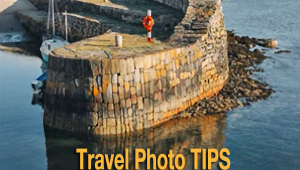Travel Photography Tips
Traveling is a popular pastime, especially among photographers. In many ways "travel photography" is just like photography at home: good exposure is still good exposure, good composition is still good composition, etc. But there are some things traveling photographers have to consider that don't affect at-home photography.
One of course, is that you're traveling.
According to the TSA (Transportation Security Administration) website (www.tsa.dot.gov/public), the equipment used today for screening checked baggage will damage undeveloped film. So don't put undeveloped film (whether exposed or unexposed) in your checked baggage. The TSA website also says that the equipment used for screening carry-on baggage can damage higher-speed films if it passes through more than five times. None of the screening equipment should damage processed film or digital images. So, it's probably best to shoot your travel photos with a digital camera if you travel by airliner. If you do use film, carry it on and have it hand-inspected. Federal Aviation Regulations (notably FAR 108.17e) do give air travelers in the U.S. the right to request a non-x-ray inspection of their film, but you can facilitate things in crowded lines by removing your films from their boxes and plastic packaging, and putting the cassettes in a plastic baggie. Lead-lined film bags provide some protection, but if the scanner can't see what's in it, the operator will either turn up the power on the scanner, or hold up the item to physically check what's in the lead-lined bag.
Ideally, you'll keep your photo gear with you at all times while traveling, to avoid damage and theft. The TSA website states that you may carry one bag of photo equipment in addition to one carry-on and one personal item through checkpoints, although individual air carriers might not allow the additional carry-on item on their aircraft. So it's a good idea to check with the airline prior to your departure date to learn the best way to deal with your photo gear on that flight.
At home, you have access to all your photo gear. When traveling, you'll want to minimize the amount of gear you have to deal with. A wide-range zoom lens can replace several fixed-focal-length lenses. But it's a good idea to carry twice as much film as you think you'll need (ISO 400 color-print film is probably the most versatile choice, but your favorite everyday films should do), extra memory cards if you're shooting digitally, and spare batteries (with charger compatible with the electricity at your location), because these items might not be available on location. If film and processing services are available, you might consider buying film on location and having it processed there, to avoid possible x-ray damage. Single-use cameras (brought from home or bought on location) are handy when traveling to risky areas so you don't have to worry about damaging or losing your "good" camera.
Of course, you should check the operation of all items before the trip, so you can have any problems repaired before you set off.
Do some research to learn about your destination's photographic possibilities, local rules regarding cameras and photography, and generally what to expect when you get there. Contact a city's chamber of commerce, or a country's tourism office, and ask for literature and suggestions. Do a Web search for information about your destination(s). Look up articles about your destination in publications like National Geographic and travel magazines, to see what the pros photographed there and how they photographed it. Pro travel photographers spend days or even months covering a specific location; since you probably can't do that, you should try to learn all you can about your destination and its potential photo opps before you go.
- Log in or register to post comments

















































